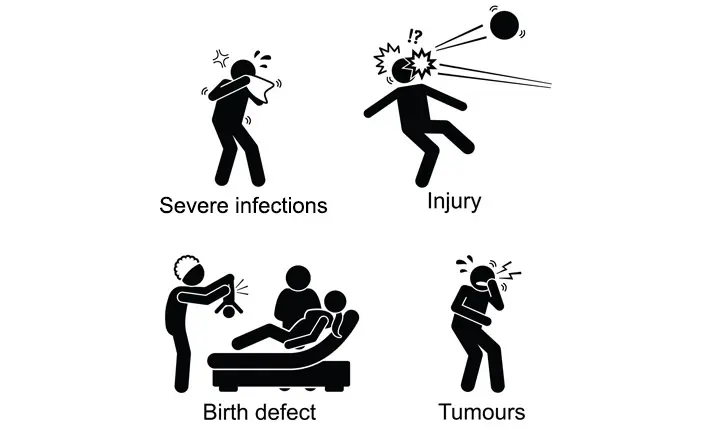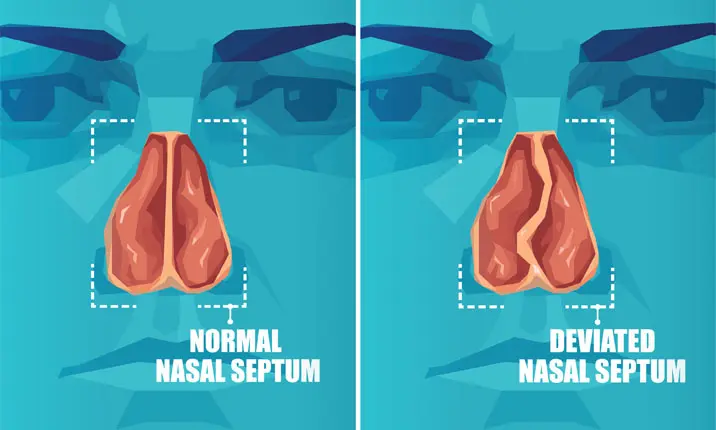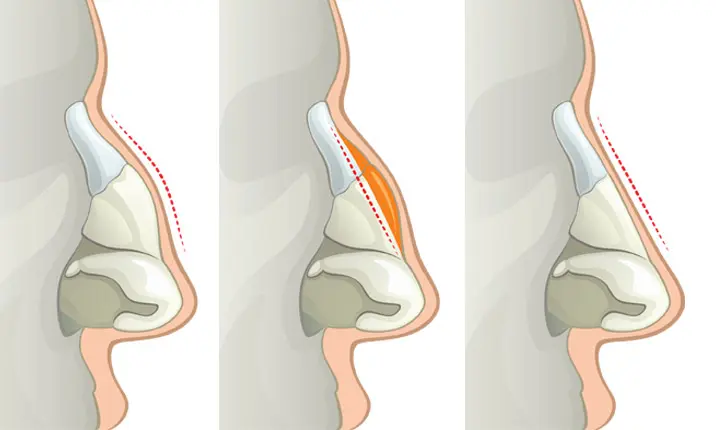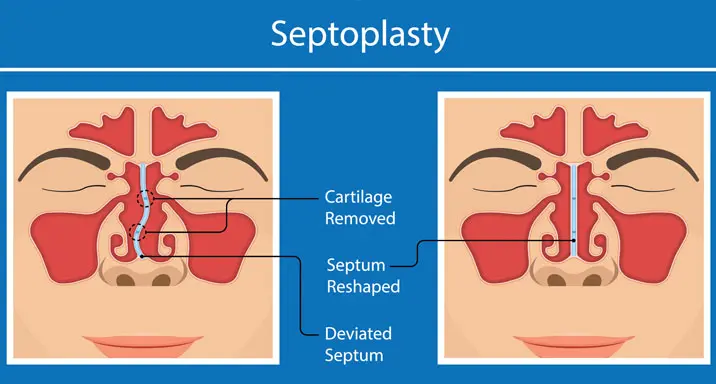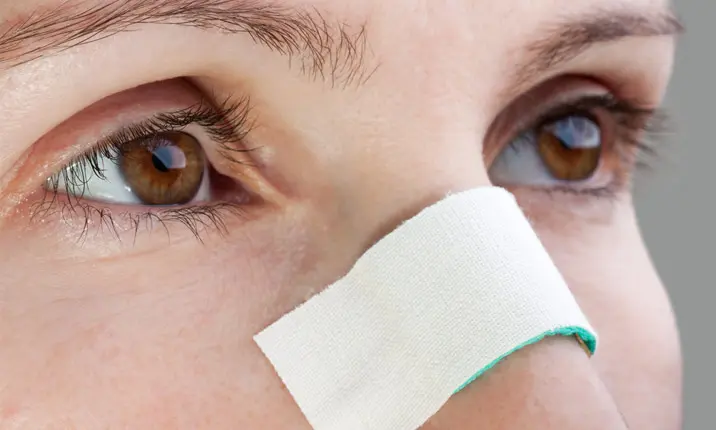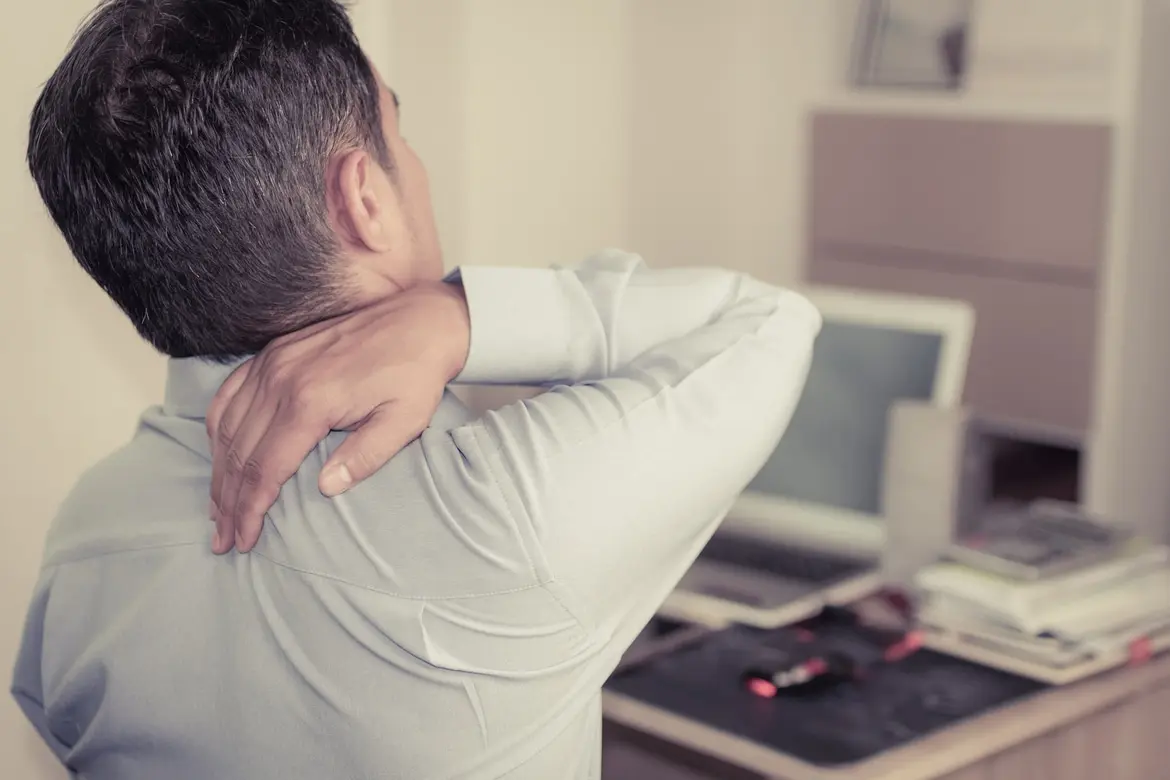What is a crooked nose?
Everyone's nose is different, but a crooked nose is one that doesn't follow a straight, vertical line down the centre of the face. From the side, the nose can appear "hooked". Some crooked noses are hardly noticeable, others are more obvious, depending on the cause of the condition. Although usually just a cosmetic concern, a crooked nose may often affect your breathing.
Causes of a crooked nose
Within the complex system of bones, cartilage, and tissue that make up your nose, a C-, I-, S-shaped or "hooked" nose is usually the result of:
- Birth defects
- Injuries, such as a broken nose
- Severe infections
- Tumours
Consult with your doctor to find out what is causing your nose to appear crooked.
Deviated nasal septum
A deviated septum is the condition where the internal "wall" of your nose that separates the left and right nasal passage leans to one side, partially blocking the nasal passage. Although some people are born with this condition, it can also develop following an injury.
Signs and symptoms of a deviated nasal septum
Most deformities of the septum result in no symptoms, and you may not even be aware that you have a deviated septum. Some, however, may cause the following signs and symptoms:
- Difficulty breathing. Blockage of one or both nostrils can make it difficult for air to pass causing breathing difficulties.
- Nosebleeds. Drying of the nasal septum surface may increase the risk of nosebleeds.
- Facial pain and headaches. A severe deviated septum may result in the touching of surfaces within the nose, causing pressure and pain. You may also experience headaches from built-up pressure in your head because air is not always flowing freely through your nasal passages.
- Snoring. A deviated septum may cause loud breathing and snoring when you sleep.
- Sinus infections. Having a clogged airway makes a person more prone to developing sinus infections.
When one side of your nose is blocked
Most of us don't realise it, but every 4 – 6 hours, one side of our nose becomes more congested and the other side decongests. This process alternates between the 2 nasal passages and is called the nasal cycle.
When one-sided nasal congestion is noticeable, it could be due to the following reasons:
- Side sleeping. You may experience congestion in the nostril that faces down when you sleep on your side.
- Deviated septum. A continuous blockage in one nostril may be due to a deviated septum.
- Inflammation and nasal polyps. Chronic inflammation and nasal polyps may cause persistent obstruction on one side of the nose. In rare cases, this could be due to a tumour.
- Foreign objects in the nose. Small children may be prone to having blockage in one nostril due to a foreign object that they put in their nose.
Can I fix my crooked nose without surgery?
Whatever solutions you may find online for non-surgical treatments, the reality is that you can't change the shape of your nose permanently without surgery. Some may consider camouflaging the asymmetrical appearance of the bones and cartilage by filling in the soft tissue areas of your nose with injectable material, such as soft tissue fillers. As these fillers may present side effects, discuss this option carefully with your doctor before deciding if it is the right treatment for you.
Surgical options
While fillers can help to slightly improve crooked noses, surgery is typically required for more severe cases.
Rhinoplasty
Rhinoplasty is surgery that changes the shape of the nose. There are 2 types of rhinoplasty – functional rhinoplasty to improve breathing and sinus concerns caused by an injury or a birth defect, and cosmetic rhinoplasty to alter the shape of the nose for aesthetic reasons.
Both surgeries can be performed under general or local anaesthesia and can range from minimally invasive to more extensive surgery depending on the extend of correction required.
Your surgeon will make small cuts between or inside your nostrils, and then separate your skin from your cartilage or bone. Reshaping on the nose is done after that by adding or removing skin, cartilage, bone, or all three.
Rhinoplasty is a challenging operation. As with any other major surgery, there are risks associated with the procedure such as:
- Bleeding
- Infection
- Adverse reaction to the anaesthesia
- Difficulty breathing through the nose
- Permanent numbness in and around the nose
- Pain, discoloration, swelling or scarring
- An uneven-looking nose and the need for additional surgery
- A hole in the septum
Slight changes to the structure of your nose can make a large difference in the appearance of your nose. Most of the time, a rhinoplasty will give satisfying results to both you and your surgeon. However, in some cases, a second surgery may be necessary for further changes.
A successful rhinoplasty would correct the structural deformities of your nose, improve breathing difficulties, help you get better sleep, and even increase your confidence.
Septoplasty
Septoplasty is a surgical procedure to straighten the bone and cartilage that divides the space between your 2 nostrils, known as the septum. It is done to relieve breathing difficulties that are caused by a severely crooked septum. It can be performed together with a rhinoplasty or as a stand-alone procedure when only the septum needs to be straightened and no external change in appearance of the nose is required.
The procedure is usually done under general anaesthesia. Your doctor makes incisions inside your nose on the cartilage or bones to trim, reposition or replace them. The incisions are closed with absorbable sutures. Packing of the nose with gauze and nasal tampons are not necessary these days and patients can avoid having to stay in the hospital to have their packs removed several days later.
Following surgery, your nasal tissues will be stable within 2 – 4 months. The cartilage and tissue may still gradually move or reshape for up to 1 year or more after surgery.
The vast majority of people experience improvement in symptoms after undergoing a septoplasty. On rare occasions, some may need a second surgery to further refine the nose and septum. The change in the airway can be life-changing for many patients who have lived with an obstructed nasal passage for a long time.
Risks from a septoplasty surgery include the following:
- Bleeding
- Infection
- Adverse reaction to the anaesthesia
- A change in the shape of the nose
- Decreased sense of smell
- A hole in the septum
- Blood clots in the nasal space requiring drainage
Preparing for surgery
Your surgeon will review your medical history and conduct a physical exam to see if you are suitable for surgery. You will be advised not to take any blood thinning medication such as clopidogrel or aspirin for 1 week before your surgery.
Recovery from surgery
As the surgery is performed as day surgery, you usually can get discharged after a few hours of rest post-operation. Make sure you get someone to pick you up as you will not be allowed to drive.
While recovering over the next 2 weeks, avoid:
- Blowing your nose
- Excessive chewing
- Facial expressions that require excessive movement (laughing)
- Painkillers containing ibuprofen or aspirin
- Physical contact with your nose
- Smoking
- Strenuous physical activities
- Swimming


